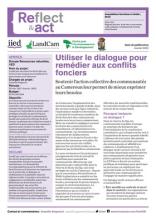/ library resources
Showing items 1 through 9 of 21.Le Code minier du Mali dispose que les ressources souterraines appartiennent à l’État, même s’il s’agit de terres agricoles. Cette disposition consacre le droit souverain de l’État sur les ressources du sous-sol, qui en organise l’accès et l’exploitation.
Les dynamiques migratoires dans les zones agricoles, liées à la conjugaison de facteurs structurels et conjoncturels, prennent de l’ampleur et posent de nouveaux défis dans la gestion des conflits fonciers.
Au Cameroun, l’augmentation des investissements à grande échelle, dans des secteurs tels que l’agro-industrie, l’exploitation minière et forestière, a entraîné de nombreux transferts de droits fonciers des communautés locales vers les acteurs commerciaux.
Despite the existence of a legal framework defining the right to fair compensation, and notwithstanding the vast literature on transnational and domestic land deals, no theory has been developed so far to allow for a specific analysis of the economics of fair compensation in large-scale land acqu
The race for the exploitation of natural resources has brought challenges of different natures, including land conflicts, mainly between investors and the local population.
In Africa, farmer-herder conflicts can be partially attributed to linguistic differences that impede communication and conflict resolution. This tension can be further amplified by climatic shocks that increase incentives to fight for resources.
Armed conflicts are among the major disruptions affecting local food systems in low- and middle-income countries, having devastating effects on populations’ food security.
Context and Background:
Paginación
Land Library Search
Through our robust search engine, you can search for any item of the over 73,000 highly curated resources in the Land Library.
If you would like to find an overview of what is possible, feel free to peruse the Search Guide.







